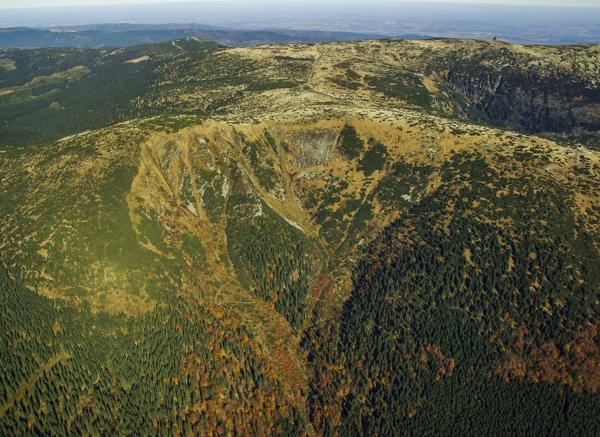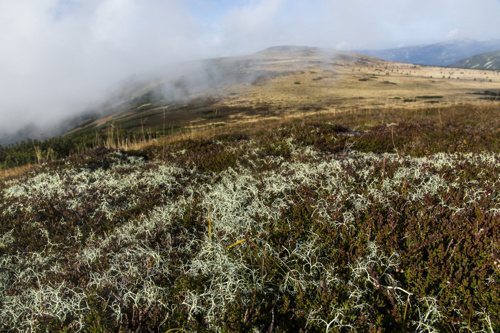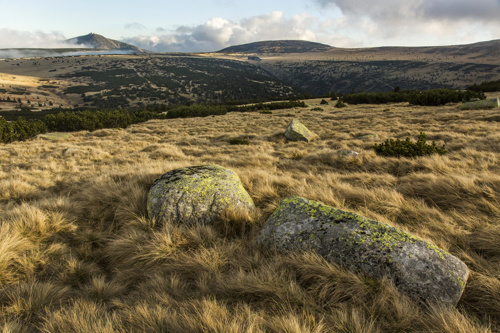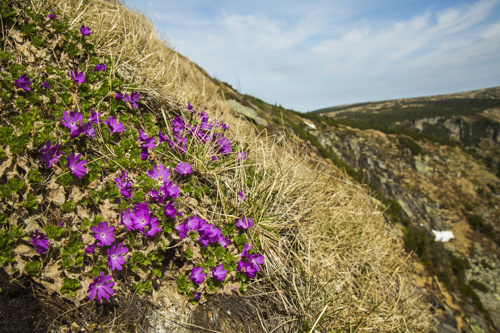There is an increased risk of spontaneous fall of branches and trees throughout the National Park, where the laws of nature govern the formation and termination of trees. Enter the forest at your own risk!
The tundra environment and the local glaciation of the Krkonoše Mountains were first described in 1894 by the German geographer J. Partch, then by the Swedish geologist B. Högbom, Czech natural scientists J. Podpěra or E. Hadač sought to explain the similarity of the landscape of the Krkonoše and northern Europe. The palynologists K. Rudolph and R. Firbas used the term "subarctic peat bogs" in their works from the Krkonoše, the geologist J. Kunský wrote about the ridges of the Krkonoše as "overgrown tundra left over from the Ice Ages", the geomorphologists J. Sekyra, A. Jahn and geobotanist J. Jeník described periglacial phenomena on the ridges of the Krkonoše, Hrubý Jeseník and Králický Sněžník. Scientists gradually realised how the Krkonoše and the whole High Sudetes are a unique environment in the middle of Europe. How the development of these geologically old mountain ranges is much more similar to the development of the landscape in northern Europe than to the development of the "younger" Alps, Pyrenees or Carpathians.

Decades of research into all the phenomena of Krkonoše nature and their comparison with other mountain ranges in Europe led to the description and definition of the Arctic-Alpine tundra of the Krkonoše and its distinction from the tundra environments of Scandinavia and the Alps at the end of the 20th century. The term Arctic-Alpine tundra best describes what took place in Central Europe during the cold periods of the Pleistocene and early Holocene and what continues to exist as a living museum of these events.
The highest peaks of the Krkonoše Mountains with shallow rocky soils - Sněžka, Obří hřeben, Luční and Studniční hora, Malý Šišák, Smogornia and Vysoké Kolo - are covered by the cryo-eolian zone. It is exposed to the long-term influence of frost (cryo-) and wind(eo-). In the ice ages, with the existence of permafrost, intensive frost weathering, subsequent sorting of weathered areas, alternating deep freezing and thawing of the soil and soil flow (solifluction), the peaks and their slopes were thus stepwise remodelled into cryoplanation terraces, large stone seas were formed, various types of frost (cryogenic) and solifluction soil forms - polygons, strips and furrows, solifluction mounds.

Even nowadays, it is the most climatically harsh area of the Krkonoše Mountains (the average annual temperature is only around +1 °C). The snow cover is low due to strong winds and lasts only a few months a year. The paradox is that the snowfields are conditioned by the incisions of the cryoplanation terraces. Frost processes - albeit with much less intensity - still maintain a cryorelief that is exceptional in the Central European mountains and whose equivalent can only be found in the polar tundra and cold high deserts of the world.
The frost- and wind-disturbed vegetation consists of plant communities that cannot tolerate higher and longer-lasting snow cover. These include rare northern and alpine lichens and bryophytes. The fauna here includes arthropods, especially insects (butterflies, dicotyledons, ground beetles), many of which are glacial relics.
Just less than 200 metres below the peaks, in the vicinity of Luční and Labská bouda, there are two large plains covered with a mosaic of alpine grasslands dominated by matgrass, dwarf pine and northern structured peat bogs. These are less windy, slightly sloping places with high snow and rain precipitation (approx. 1200 mm/year). Snow cover averages around 180 cm, persists for more than half the year, and spring and summer snowfields are common. The average annual temperature is around +1.6 °C. The weather mantle and podzol soils are deeper here. All this has allowed the lush development of grassland and peatland vegetation in the past, which has covered the frost-shaped relief of the polygonal and furrowed soils. Other shapes have been created by solifluction, notable are mountain rosary flows, wandering stone blocks, peat mounds of pounikos or peat heaps reminiscent of the Nordic pastures. It is a landscape similar to the polar and sub-polar regions in northern Europe, but also in Patagonia or New Zealand.

Peat bogs began to form in the Krkonoše Mountains about 7,000 to 5,000 years ago. Many of the local plants are common in northern Europe and arrived in the Krkonoše a long time ago as ambassadors of the polar tundra. These include the cloudberry, Carex bigelowii, Sudetic Lousewort and Lindberg Bog Moss. The Krkonoše Mountains are the southernmost outpost of their distribution. The fauna hosts many glacial relics, such as spiders, dragonflies and the wetland vole, whose populations change cyclically. Outside the winter season, deer come out here.
Extends in the leeward part of the A-O systems. The deep amphitheatres of glacial cirques (locally known as 'pits') are the part of the tundra where frost weathering of the rock faces has been at work for many millennia, with massive snowdrifts forming on the edges in winter and avalanches abrading the slopes. In the past, they were filled by glaciers. The main agents are ice (niveo-) and ice (glaci-), from whence comes the term niveo-glaciogenic zone. It also includes snow depressions, nivation depressions and slopes with summer snow fields.

Especially in the cirques, however, the effects of a favourable microclimate, sufficient moisture and the mineral wealth of the exposed rock walls are combined. Snow avalanches throughout the Holocene have fostered the emergence of an extraordinarily varied mosaic of ecosystems (e.g. spring beds, alpine alluvial floodplains, shrub communities), where foothill and lowland species live in close proximity to mountain and northern plants and animals, cold-loving organisms alongside thermophilic ones, light-loving ones alongside shade-loving ones. This is the environment of the Krkonoše botanical gardens, which were already well known and named by our ancestors long before the arrival of explorers (e.g. Krakonošova zahrádka Garden or Čertova zahrádka Garden, with Schustlerova zahrádka Garden and Kotelská zahrádka Garden added later, among others). The richest in species is Čedičová rokle (Basalt Gully) in the Malá Sněžná jáma Pit on the Polish side of the mountains. The analogue of the flowering tundra of the Krkonoše cirques is the Velká kotlina Basin and the Malá kotlina Basin in Hrubý Jeseník. These are the richest places in the European Central Mountains.